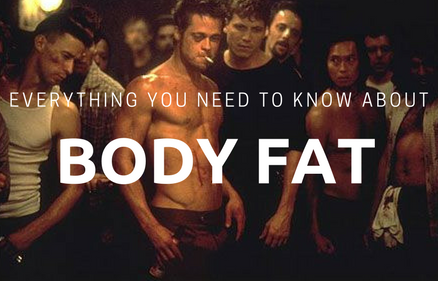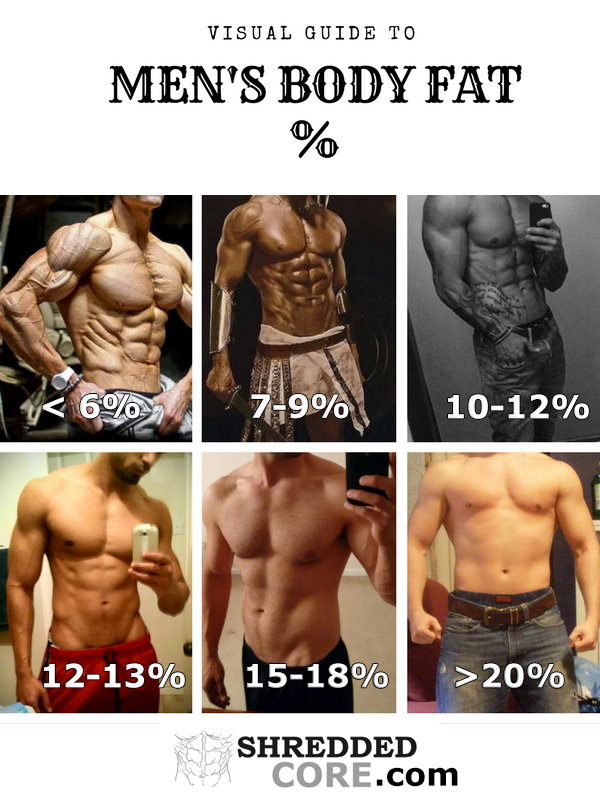Your body fat percentage is a measure of how much fat you have in your body, and how much of your body is made up of fat.
It is a useful thing to know, and can really help people to diet and exercise more effectively. On the other hand, it is often taken way too seriously by beginners and can contribute to a loss in motivation, and an unrealistic portrayal of your progress.
In this guide we are going to look at the benefits of knowing your body fat percentage, a number of different methods of estimating it, and we are going to explain why your body fat percentage is nothing more than a tool to help you, rather than something to be stressed over, or proud of.

What is Body Fat?
You have two forms of body fat, there is essential fat and storage fat. Men and women have different amounts of essential body fat which is why women require a higher level of body fat to stay healthy.
Essential fat is the fat required for your body to perform maintenance, and to reproduce. If your level drops below that it can be very dangerous to your health.
Storage fat does have its uses too, and you don’t want to spend prolonged amounts of time with almost zero storage fat. Stored body fat can help you absorb certain vitamins (A,E,D, and K), it can insulate you in cold weather, and protect your bones and organs.
But excess fat has many downsides too, and most people have too much.
Visual Guide To Men’s Body Fat Levels
Here’s a handy visual guide we’ve made that will give you an estimate of what certain body fat percentages look like on athletic males that engage in weight lifting.

Disclaimer: Every individual holds fat differently. It’s purely genetic. This chart is in no way a 100% accurate measure. Don’t get stressed out about it.
What is Lean Body Mass?
Let’s say you weigh 100kg and you have a body fat percentage of 20. This means that 20% of your body is made up of fat, while 80% is made up of lean mass, your lean body mass is therefore 80kg. This includes muscles, bones, and organs.
The main reason why we measure body fat percentage is so that we can work out our lean body mass. Not so that we can walk around telling people our body fat percentage number!
Why is it Useful to Know your Body Fat Percentage?
If you are dieting properly you’ll be using a calorie and macro target. In other words you’ll have an idea of how much protein, how much fat, and how much carbohydrates you should be eating each day.
Most online calculators use your body weight to create this total, but this can lead to wildly inaccurate results.
Because a professional boxer and an out of shape student could have the exact same body weight and height, even if one has six pack abs, while the other has a six pack of Budweiser.
The boxer may weigh 100kg but be only 10% body fat (meaning that he is almost all muscle) while the student may be 35% body fat (meaning that he has a lot less muscle).
They are clearly very different body shapes, but a simple calculator would produce the same results.
By knowing your body fat percentage and your lean body muscle mass, you can get a much more accurate idea of your current level, and whether you need to lose fat or gain muscle (or both).
What are the Different Methods of Estimating Body Fat Percentage?
Scientists say the only true measure of body fat percentage requires a cadaver and a consent form! Because unless you are prepared to be cut open you will only ever be able to estimate it.
Obviously nobody is going to do that! But it is important to note that none of the methods mentioned below are going to be completely accurate.
This section is going to describe the four main methods for estimating body fat percentage before giving you an idea of which one may be the most effective.
Method #1. The Bod Pod – We’ll start off with the most effective method possible, which is the Bod Pod.
What is it? Well it’s a pod that you climb into that measures the displacement of air that your body creates. It’s similar to a method called hydrostatic weighing which dunks you into water and then measures the change in your body weight while outside and inside the water.
The Bod Pod does the same but using air, which saves you from being dunked into a swimming pool. While this method gives you a decent estimate, it is wildly impractical for the average person.
This is because a Bod Pod costs around $50,000!
Method #2. Skinfold Callipers – This is the preferred method of personal trainers, and if you’ve ever had a dedicated trainer you have probably experienced being pinched by a set of callipers.
The callipers are placed at strategic parts of your body (between 3 and 7 different places) and 3 measurements are taken to find an average.
Afterwards the numbers are fed into an equation by Jackson & Pollock (1978) that gives you a body fat percentage [1].
But the problem with skinfold callipers (other than the fact that they hurt) is that they are only as reliable as the measurer. The person doing the testing need to be very accurate, and sadly 90% of them aren’t.
This can lead to people getting very wrong numbers, and most trainers who use them probably end up just making it up!
Method #3. Bioelectrical Impedance – This is the most commonly used method for assessing body fat. Many scales come with little handles which you place your hands over (or some where you stand on them), these send small electric signals through your body and in theory gives the machine an estimate as to what percentage of your body is made up of fat.
Sadly, they are incredibly inaccurate and can be influenced by how hydrated you are, whether you have eaten recently or not, and whether you have recently exercised.
Method #4. Visual Estimation – This last one sounds like the least scientific of the lot, but it can be surprisingly effective. Just look at a chart of different body fat percentages and decide which one best represents your body.
Or better yet get a neutral party to do it.
Take a photo of yourself without a shirt on, and without posing. Then compare it to the chart, whichever photo matches yours most closely represents an estimate of your current body fat percentage.
So there are four different methods for body fat testing, there are a few others out there but they are even more impractical than the bod pod! One thing that is incredibly important for you to understand though, is that your body fat percentage is just a number.
Something that you can use to ensure you are eating enough protein, or aiming for the right calorie target. That number does not define who you are, nor is it something to be ashamed/proud of.
What is a Good Target Body Fat for Men?
Depending on your goals, your body fat percentage can be anywhere from 14% to 25%. Some people are naturally lower than that, and others will struggle to hit 25%, so any advice here is very general.
If you are looking to be healthy then around 18-25% is a great target.
If you want to look good naked, then 10-15% is a more difficult (but more rewarding) target.
Finally, if you want to be ripped to shreds then you should be aiming for around <9%.

But remember that essential fat we mentioned? When you get down to just that (i.e. you have burned all of your storage fat) you are putting yourself in danger.
Your immune system will not function as well, your testosterone will drop, your sleep will suffer, and so will your mood.
That’s why most men who drop down to that level, only do so for short periods of time.
Aim to peak for certain events (holidays, photo shoots, competitions etc), and then bring yourself back up to that 10-18% sweet spot.
What is a Good Target Body Fat for Women
Women require more essential body fat to survive (10-12% rather than <6%) so all of their ranges will be slightly higher than men.
Most women should be aiming for 25-31% as a healthy target, but women who want to excel in sport may need to drop down to around 20%.
If a woman wanted to get shredded then they would need to aim for 12-15%, but as with men this could cause hormonal and reproductive issues.
Final Thoughts
Find a method that works best for evaluating your body fat percentage and use that as a starting point. Don’t focus too much on that number, and use objective analysis of your own photos/reflection to gauge progress.
To lower your body fat you need to increase your energy burned, and reduce your calorie intake.
Using your body fat percentage as a guideline will help you to avoid common mistakes such as dropping too many calories, or not enough.
References
[1] Jackson, A., Pollock, M. 1978. Generalized equations for predicting body density of men. British Journal of Nutrition 40(3): 497-504
(link) https://www.ncbi.nlm.nih.gov/pubmed/718832